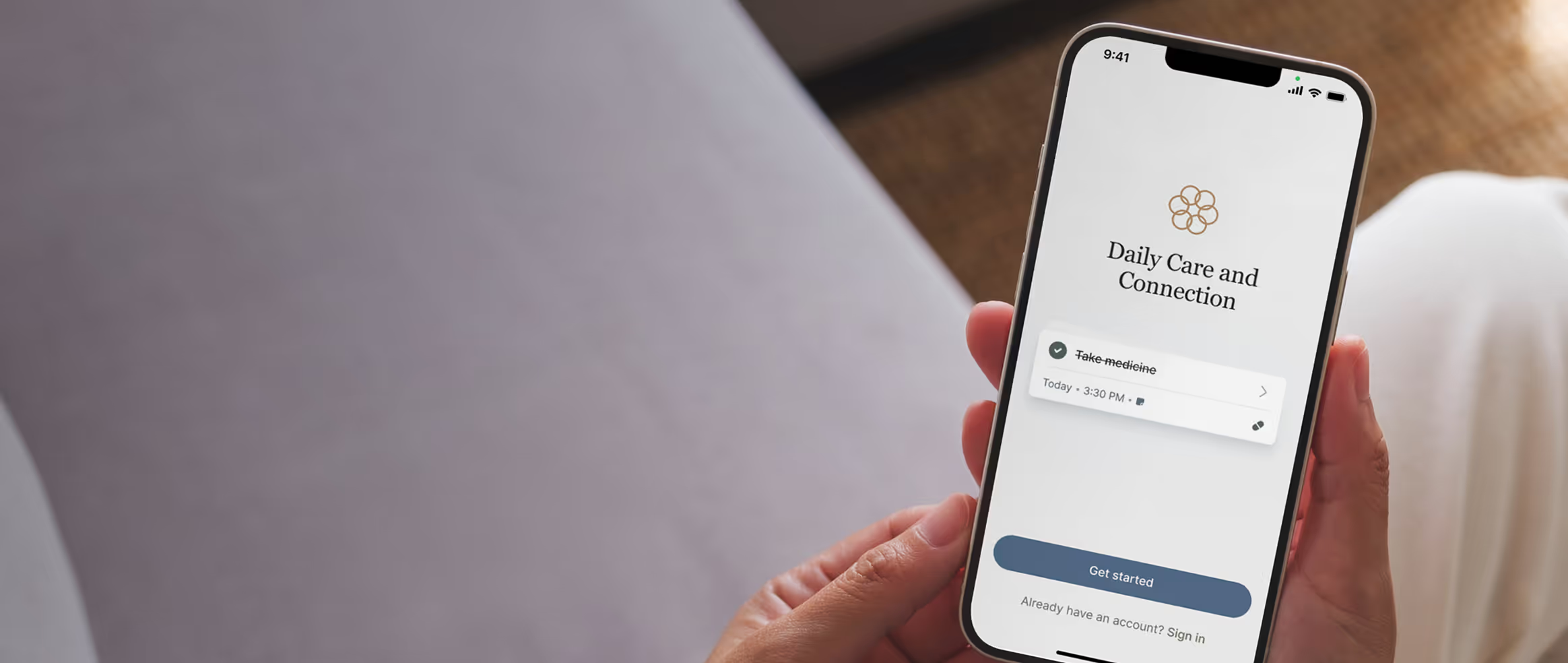Emotional Labor in Caregiving: The Hidden Weight of Caring for Others

You’ve just finished a long day of caregiving. You’ve managed medication schedules, kept appointments straight, and made sure your loved one had a good meal. Yet what feels the most exhausting isn’t the physical work, it’s staying upbeat when you’re drained, patient when you’re anxious, and kind when you’re running on empty. That invisible effort has a name: emotional labor.
For caregivers, emotional labor is more than just a side effect of caring; it’s the heartbeat of what they do every day. Understanding this hidden weight is key to protecting carers’ mental health, preventing burnout, and helping caregivers find balance between compassion and self-preservation.
What is emotional labor, and why does it matter in caregiving?
Sociologist Arlie Hochschild first coined the term emotional labor to describe the effort people put into managing emotions in their jobs, especially in roles that require empathy, patience, and warmth. While she initially focused on service workers, her research applies deeply to caregivers, whose emotional effort is constant and personal.
In caregiving, emotional labor means soothing fears, hiding frustration, or showing compassion even when you feel overwhelmed. Unlike physical care, such as bathing, feeding, or driving to appointments, emotional labor often goes unseen but can quickly lead to caregiver fatigue. It’s the silent energy drain that happens when you spend more time caring for others’ emotions than your own.
When left unchecked, this invisible work begins to chip away at your sense of self. Recognizing it means you understand what your body and mind are actually carrying.
How Emotional Labor Shapes the Caregiver Experience
Caregivers often feel pressure to stay positive, patient, and strong no matter the circumstance. Whether you’re comforting an anxious parent, supporting a partner through illness, or managing the unpredictable behaviors that come with dementia, there’s an unspoken rule that you must remain calm. Many caregivers describe this as “putting on a brave face,” even when their inner world feels anything but steady.
Over time, this expectation becomes a performance of emotional control, one that demands more energy than most people realize. You might find yourself avoiding honest conversations about how hard things are because you fear worrying others. Or you might downplay your exhaustion to keep the peace. This kind of suppression doesn’t just create mental strain; it slowly distances you from your own emotions and needs.
The emotional balancing act also affects relationships. A caregiver may feel resentment when others don’t notice their efforts, or guilt when they finally express frustration. The constant switching between empathy, patience, and restraint can leave little room for joy or spontaneity. You start to feel like you’re managing everyone’s emotional state, including your own, around the clock.
And when gender expectations enter the picture, the weight becomes even heavier. Women, in particular, are often socialized to take on emotional caregiving roles both inside and outside the family, while men may feel pressured to suppress vulnerability. In either case, the result is the same: an internalized belief that expressing pain equals weakness. This belief can silently deteriorate carers’ mental health, turning emotional labor into a barrier to self-compassion and connection.
Recognizing how emotional labor shapes every aspect of caregiving is the first step toward healing. By naming the emotional costs of care, you reclaim ownership of your own well-being and begin to create space for balance and authenticity in your role.
The Connection Between Emotional Labor and Caregiver Burnout
The link between emotional labor, caregiver burnout, and caregiver depression is well-documented. When you constantly put others’ needs first and suppress your emotions, your stress hormones remain elevated, leading to emotional and physical exhaustion.
AARP reports that 23% of caregivers report difficulty in caring for their own health as a result of their caregiving. Burnout doesn’t always start with anger or fatigue; sometimes it begins with silence and a lack of joy. This ongoing strain is what transforms emotional labor from a healthy expression of empathy into an unhealthy burden that fuels caregiver fatigue.
Acknowledging the emotional side of care helps sustain your emotional and mental well-being by restoring balance and resilience before burnout sets in.
Recognizing the Signs of Emotional Exhaustion
Emotional exhaustion often creeps in quietly and feels different from the sudden crash of physical tiredness. You may notice that minor frustrations feel overwhelming or that your usual patience is harder to access. You might feel guilty for wanting time alone or anxious that stepping away makes you selfish. Over time, laughter feels less spontaneous, and even activities you once enjoyed may start to feel like obligations. Your compassion can feel dulled, replaced by numbness or irritability.
One of the key differences between emotional exhaustion and caregiver burnout lies in the intensity and recovery aspects. Emotional exhaustion is the early warning stage; it signals that your emotional reserves are running low but can still be replenished with rest and support. Burnout, on the other hand, is a deeper state of depletion where recovery feels difficult, motivation disappears, and emotional detachment takes hold. Emotional exhaustion can still be reversed, while burnout often requires extended time, boundaries, and sometimes professional help to heal.
If you find yourself avoiding calls, feeling detached from your loved one, or struggling to empathize, those are signs that your emotional well has run dry. This is your cue to slow down, rest, and reach out. Check in with yourself daily: Am I feeling drained, or am I feeling done? The answer helps determine whether you need a break or a bigger change in how you care for yourself as you care for others.
The Gendered Side of Emotional Labor in Caregiving
Society often assumes women will naturally take on caregiving roles, and with them, the emotional labor that comes along. They’re expected to be compassionate, patient, and available, often at the expense of their own needs. This expectation is reflected in national data: according to Caregiving in the U.S. 2025, three in five caregivers are women (61%), while only two in five are men (38%). The same report shows that more women than men report physical strain (21% compared with 16%) and emotional strain (41% compared with 33%) while caregiving. Additionally, 26% of female caregivers report difficulty taking care of their own health, compared with 23% of caregivers overall.
These numbers highlight how women disproportionately shoulder not only the logistical but also the emotional weight of caregiving. Many manage multiple roles: parent, partner, employee, while still being the emotional anchor of their families. They often balance caregiving with paid employment; yet women who work while caregiving are more likely to be hourly workers (55%) compared with 47% of male caregivers. This financial imbalance compounds the emotional one, leaving women at higher risk of stress-related health issues and caregiver fatigue.
Yet men who become caregivers face challenges too. Cultural norms can discourage them from expressing vulnerability, making it harder to ask for help or acknowledge emotional strain. Regardless of gender, every caregiver deserves recognition for the emotional work they do and access to support that validates their experience.

How to Manage Emotional Labor Without Losing Yourself
You can’t stop caring, but you can start caring differently. Managing emotional labor begins with awareness and permission, the permission to feel your feelings without judgment.
Start by naming what you feel throughout the day, rather than suppressing it. Labeling emotions (“I’m frustrated,” “I’m anxious,” “I’m lonely”) helps you acknowledge your reality instead of internalizing it. This awareness allows you to respond intentionally rather than react automatically.
Practical strategies can also help lighten the emotional load. Try journaling about your emotions instead of burying them; it creates distance and clarity. Set aside time for self-reflection or use mindfulness practices to reset your mind between caregiving tasks. Therapy or support groups can provide validation and understanding, reminding you that you’re not alone in this experience.
Boundaries are another essential form of self-care. That might mean saying no to extra responsibilities, asking family members to share specific tasks, or limiting emotionally draining conversations. These boundaries protect your energy so you can continue showing up fully when it matters most.
Creating small rituals of rest can also build resilience: a morning walk, a quiet cup of coffee before the day begins, or a gratitude list before bed. These seemingly minor acts replenish emotional reserves over time. And when you feel guilt for prioritizing yourself, remind yourself that your well-being directly influences the quality of care you give.
For caregivers balancing multiple roles, using tools that simplify communication and organization can reduce emotional stress. Apps like Caily help by centralizing schedules, notes, and updates in one place, freeing up mental space for recovery and connection. By tending to your emotional health, you protect your physical and mental energy, creating space for joy to return to the caregiving experience.
Building Support Systems That Acknowledge Emotional Labor
Caregiving shouldn’t be a solo act. Workplaces, families, and communities all play a role in easing the emotional weight of care. Digital tools like Caily make it easier to share updates, delegate tasks, and reduce the constant worry that fuels emotional strain.
When systems acknowledge carers’ mental health, caregivers feel less isolated and more valued. Employers who offer mental health resources or caregiving benefits can make a tangible difference. Awareness of emotional labor helps create stronger, more empathetic caregiving relationships, ones that honor both the care receiver and the caregiver.
Redefining Strength and the Role of Caily in Caregiving
Caregivers are often praised for their strength, yet true strength lies not in silence but in honesty. Allowing yourself to express frustration, sadness, or fear can lighten the invisible load of emotional labor. When caregivers share their emotions openly, they create space for understanding, connection, and healing, both for themselves and those they care for. This kind of honesty turns caregiving from an isolating responsibility into a shared experience grounded in trust and empathy.
But emotional awareness alone isn’t enough; caregivers also need structure and support. That’s where Caily comes in. Built to make caregiving easier both emotionally and practically, Caily helps organize the countless details of daily care, so caregivers can focus on what matters most: meaningful connection. With tools like Daily Check-Ins, shared calendars, and secure communication features, Caily lightens the cognitive and emotional load that often leads to caregiver burnout.
By simplifying care coordination and fostering family communication, Caily helps caregivers build resilience, find peace of mind, and rediscover the joy in caring. It’s not just about managing care but protecting the emotional heart of caregiving itself.
Frequently Asked Questions About Emotional Labor in Caregiving
What is emotional labor in caregiving?
Emotional labor means managing your own emotions while caring for someone else. It’s the unseen effort that can lead to caregiver fatigue and affect carers’ mental health if it goes unrecognized.
How is emotional labor different from caregiver burnout or depression?
Emotional labor is the daily emotional effort of caregiving. Caregiver burnout and caregiver depression develop when that effort becomes overwhelming and prolonged, leading to exhaustion or sadness.
How can caregivers protect their mental health while managing emotional labor?
Supporting carers’ mental health starts with recognizing emotional labor early. Take short breaks, ask for help, and use supportive tools like Caily to reduce stress and avoid caregiver fatigue.

Get Started Now
Enjoy full access to everything Caily offers, from medication tracking to shared schedules and daily check-ins. See how much easier caregiving can be when everything is coordinated in one place.
Start your free trial
